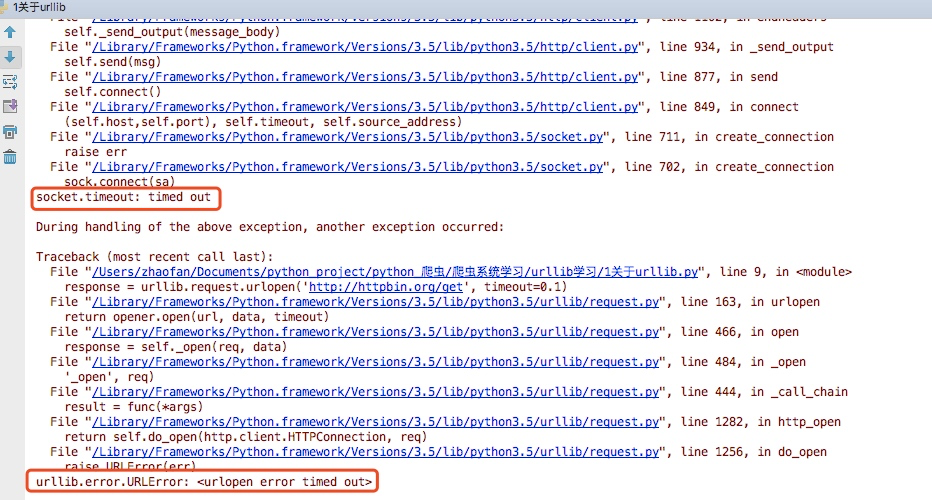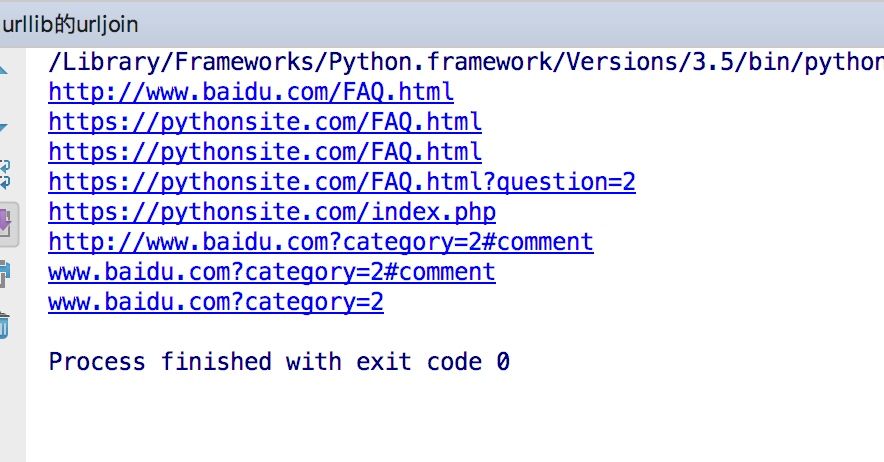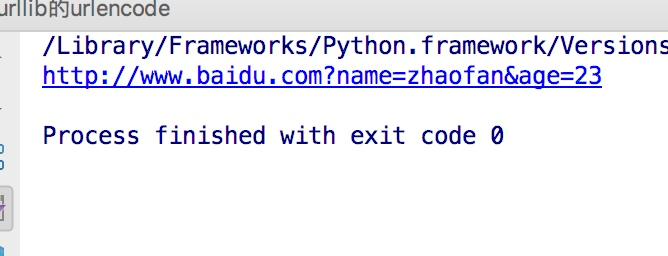urllib
爬虫url
# url格式分为三部分: ①第一部分是协议 (或称为服务方式)。 ②第二部分是存有该资源的主机 IP 地址 (有时也包括端口号)。 ③第三部分是主机资源的具体地址,如目录和文件名等
爬虫环境
# Notepad++ # windows: PyCharm # linux : Eclipse for Python 提供给开发者10款最好的: https://www.oschina.net/news/57468/best-python-ide-for-developers
Urllib库
根据url获取他的网页信息
结构:urllib.requeset.urlopen(url,data,timeout)
HTML为骨架
JS为肌肉
CSS为衣服
post请求
import urllib.parse import urllib.request data = bytes(urllib.parse.urlencode({'word': 'hello'}), encoding='utf8') print(data) # 加data为post,不加为get response = urllib.request.urlopen('http://httpbin.org/post', data=data) print(response.read().decode('utf-8'))
# 这里就用到urllib.parse,通过bytes(urllib.parse.urlencode())可以将post数据进行转换放到urllib.request.urlopen的data参数中。这样就完成了一次post请求。 所以如果我们添加data参数的时候就是以post请求方式请求,如果没有data参数就是get请求方式
timeout参数的使用
在某些网络情况不好或者服务器端异常的情况会出现请求慢的情况,或者请求异常,所以这个时候我们需要给
请求设置一个超时时间,而不是让程序一直在等待结果。例子如下:
import urllib.request response = urllib.request.urlopen('https://www.baidu.com/', timeout=1) print(response.read().decode('utf-8'))
运行之后我们看到可以正常的返回结果,接着我们将timeout时间设置为0.1
运行程序会提示如下错误

所以我们需要对异常进行抓取,代码更改为
import socket import urllib.request import urllib.error try: response = urllib.request.urlopen('http://httpbin.org/get', timeout=0.01) except urllib.error.URLError as e: if isinstance(e.reason, socket.timeout): # isinstance判断类型 print('TIME OUT')
request
设置Headers
第一种方式:
from urllib import request, parse url = 'http://httpbin.org/post' headers = { 'User-Agent': 'Mozilla/4.0 (compatible; MSIE 5.5; Windows NT)', 'Host': 'httpbin.org' } dict = { 'name': 'zhaofan' } data = bytes(parse.urlencode(dict), encoding='utf8') req = request.Request(url=url, data=data, headers=headers, method='POST') response = request.urlopen(req) print(response.read().decode('utf-8'))
第二种方式:
from urllib import request, parse url = 'http://httpbin.org/post' dict = { 'name': 'Germey' } data = bytes(parse.urlencode(dict), encoding='utf8') req = request.Request(url=url, data=data, method='POST') req.add_header('User-Agent', 'Mozilla/4.0 (compatible; MSIE 5.5; Windows NT)') response = request.urlopen(req) print(response.read().decode('utf-8'))
这种添加方式有个好处是自己可以定义一个请求头字典,然后循环进行添加
高级用法各种handler
代理,ProxyHandler
通过rulllib.request.ProxyHandler()可以设置代理,网站它会检测某一段时间某个IP 的访问次数,如果访问次数过多,它会禁止你的访问,所以这个时候需要通过设置代理来爬取数据
cookie,HTTPCookiProcessor
cookie中保存中我们常见的登录信息,有时候爬取网站需要携带cookie信息访问,这里用到了http.cookijar,用于获取cookie以及存储cookie
import http.cookiejar, urllib.request cookie = http.cookiejar.CookieJar() handler = urllib.request.HTTPCookieProcessor(cookie) opener = urllib.request.build_opener(handler) response = opener.open('http://www.baidu.com') for item in cookie: print(item.name+"="+item.value)
两种写入方式
http.cookiejar.MozillaCookieJar()
import http.cookiejar, urllib.request filename = "cookie.txt" cookie = http.cookiejar.MozillaCookieJar(filename) handler = urllib.request.HTTPCookieProcessor(cookie) opener = urllib.request.build_opener(handler) response = opener.open('http://www.baidu.com') cookie.save(ignore_discard=True, ignore_expires=True)
http.cookiejar.LWPCookieJar()
import http.cookiejar, urllib.request filename = 'cookie.txt' cookie = http.cookiejar.LWPCookieJar(filename) handler = urllib.request.HTTPCookieProcessor(cookie) opener = urllib.request.build_opener(handler) response = opener.open('http://www.baidu.com') cookie.save(ignore_discard=True, ignore_expires=True)
获取文件中的cookie获取的话可以通过load方式,当然用哪种方式写入的,就用哪种方式读取
import http.cookiejar, urllib.request cookie = http.cookiejar.LWPCookieJar() cookie.load('cookie.txt', ignore_discard=True, ignore_expires=True) handler = urllib.request.HTTPCookieProcessor(cookie) opener = urllib.request.build_opener(handler) response = opener.open('http://www.baidu.com') print(response.read().decode('utf-8'))
异常处理
from urllib import request,error try: response = request.urlopen("http://pythonsite.com/1111.html") except error.URLError as e: print(e.reason)
上述代码访问的是一个不存在的页面,通过捕捉异常,我们可以打印异常错误
这里我们需要知道的是在urllb异常这里有两个个异常错误:
URLError,HTTPError,HTTPError是URLError的子类
URLError里只有一个属性:reason,即抓异常的时候只能打印错误信息,类似上面的例子
HTTPError里有三个属性:code,reason,headers,即抓异常的时候可以获得code,reson,headers三个信息,例子如下:
from urllib import request,error try: response = request.urlopen("http://pythonsite.com/1111.html") except error.HTTPError as e: print(e.reason) print(e.code) print(e.headers) except error.URLError as e: print(e.reason) else: print("reqeust successfully")
同时,e.reason其实也可以在做深入的判断,
import socket from urllib import error,request try: response = request.urlopen("http://www.pythonsite.com/",timeout=0.001) except error.URLError as e: print(type(e.reason)) if isinstance(e.reason,socket.timeout): print("time out")
url解析
urlparse
The URL parsing functions focus on splitting a URL string into its components, or on combining URL components into a URL string.
urllib.parse.urlparse(urlstring, scheme='', allow_fragments=True)
功能一:
from urllib.parse import urlparse result = urlparse("http://www.baidu.com/index.html;user?id=5#comment") print(result)
结果为:

这里就是可以对你传入的url地址进行拆分
同时我们是可以指定协议类型:
result = urlparse("www.baidu.com/index.html;user?id=5#comment",scheme="https")
这样拆分的时候协议类型部分就会是你指定的部分,当然如果你的url里面已经带了协议,你再通过scheme指定的协议就不会生效
urlunpars
其实功能和urlparse的功能相反,它是用于拼接,例子如下
from urllib.parse import urlunparse data = ['http','www.baidu.com','index.html','user','a=123','commit'] print(urlunparse(data))

urljoin
这个的功能其实是做拼接的,例子如下:
from urllib.parse import urljoin print(urljoin('http://www.baidu.com', 'FAQ.html')) print(urljoin('http://www.baidu.com', 'https://pythonsite.com/FAQ.html')) print(urljoin('http://www.baidu.com/about.html', 'https://pythonsite.com/FAQ.html')) print(urljoin('http://www.baidu.com/about.html', 'https://pythonsite.com/FAQ.html?question=2')) print(urljoin('http://www.baidu.com?wd=abc', 'https://pythonsite.com/index.php')) print(urljoin('http://www.baidu.com', '?category=2#comment')) print(urljoin('www.baidu.com', '?category=2#comment')) print(urljoin('www.baidu.com#comment', '?category=2'))

从拼接的结果我们可以看出,拼接的时候后面的优先级高于前面的url
urlencode
这个方法可以将字典转换为url参数,例子如下
from urllib.parse import urlencode params = { "name":"zhaofan", "age":23, } base_url = "http://www.baidu.com?" url = base_url+urlencode(params) print(url)







